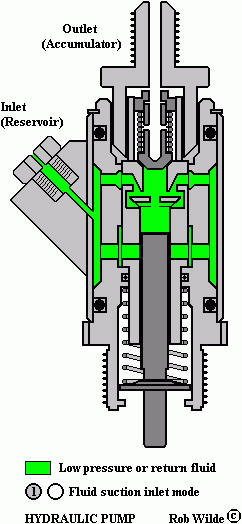Brake system
The hydraulic brake system is for the first series of the Silver Shadow a triplex system. It consists of two high pressure systems (system 1 and system 2) and a low pressure master cylinder system. These three systems work under normal conditions simultaneous but completely independent. The high pressure is made by two pumps that are mounted ont he engine and are driven by the camshaft.
The master cylinder creates pressure when the brake pedal is pushed down and operates 4 of the 16 brake pistons. The master cylinder has to be considered as a back-up system.
The master cylinder is not continued on the Silver Shadow II. The two pistons that were operated by the master cylinder, are now part of the high pressure circuit.
Height control system
The height control system takes care of keeping the car on the same height under all circumstances, regardless the number of passengers or load. The system consists of two levelling valves (height control valves) and two ram valves on the rear spring caps. The fluid is pressurised by the second circuit. When load is added and the height of the car decreases, the height control valves open and high pressure fluid flows to the ram valves. These valves push the car upwards. When the load is removed, the valves come back in their basic position. The valves are operated by a lever which is fitted to the rear subframe.
In the first four years of the Silver Shadow height control was fitted on all four spring legs. In that time a roll restrictor valve was applied that restricted the roll around the length axis. This valve too was deleted after 1969.
From 1969 (chassisnumber 7404) height levelling was fitted only at the rear side of the car. In the beginning the difference in level in the front was 1 inch and in the rear was 3 inches. From 7404 the difference in level was reduced to 2 inches (rear only).
A solenoid controls the speed of levelling the car. When the car stands still the height will be controlled 20 times as quick as when the car is driving. When someone enters the car (standstill of the car) the height is corrected immediately. When driving this can last some seconds. Whether the car is driving or standing still is detected by the position of the gear level and the door switch. In position P (park) or N (neutral) or when the door is opened the fast mode is activated. On later cars the door switch is no longer connected to the levelling system.

The beating heart of the hydraulic system: the hydraulic pumps.
Pressure
Under normal circumstances the pressure is 1850 till 1900 lb/sq.in., or 130,06 till 133,58 kg/cm².
The maximum pressure in the hydraulic system is 2500 lb/sq.in., or 175,77 kg/cm². This can be compared with a weight of 175 kilogram on one square centimeter!
The master cylinder has a section through of 5/8 inches, or 15,87 mm.
Hydraulic fluid
The hydraulic system is filled with hydraulic fluid (you better not say hydraulic oil) that has been especially developed for the Silver Shadow. The code of the fluid is RR363 and it is produced by Castrol. One of the special functions of this oil is providing lubrication to the system. This is for lubricating the hydraulic units as the oilpumps. The fluid is very hygroscopic, what means that it attracts water. When that happens the functioning of the fluid reduces. That happens in the course of the time because damp of the environment is soaked in the fluid.
While braking the brake calipers will become warmer. The fluid is composed in such a way that it will not boil. But the water that is attracted does boil which causes heat expension. It is also possible that air bells will come up in the system which causes fading of the brakes and reduction of brake performance. So it si important to replace the fluid every two years (or more frequent) regardless the distance that is driven. The ageing of the fluid can be determined by the smell in the reservoir.
Old fluid or wrong fluid (like modern Dot3 or Dot4 oil) affects the hose system and will lead to oil leakage. Dot 3 and Dot4 also have a less lubricating function. It is strongly recommended NOT to use any other fluid than Castrol RR363.
The Corniches en Camargues with chassisnumbers above 50000 (from spring 1979) are not provided any more with the RR363 fluid but with mineral fluid. The mineral fluid and the RR363 fluid may never be replaced by each other. The mineral system can be recognized by the green labels that are stuck to several hydraulic components.
To fill up the complete hydraulic system 2,5 liters (4,5 imperial pints) of hydraulic fluid are necessary.
|
 Marinus Rijkers. Disclaimer
Marinus Rijkers. Disclaimer
 Marinus Rijkers. Disclaimer
Marinus Rijkers. Disclaimer